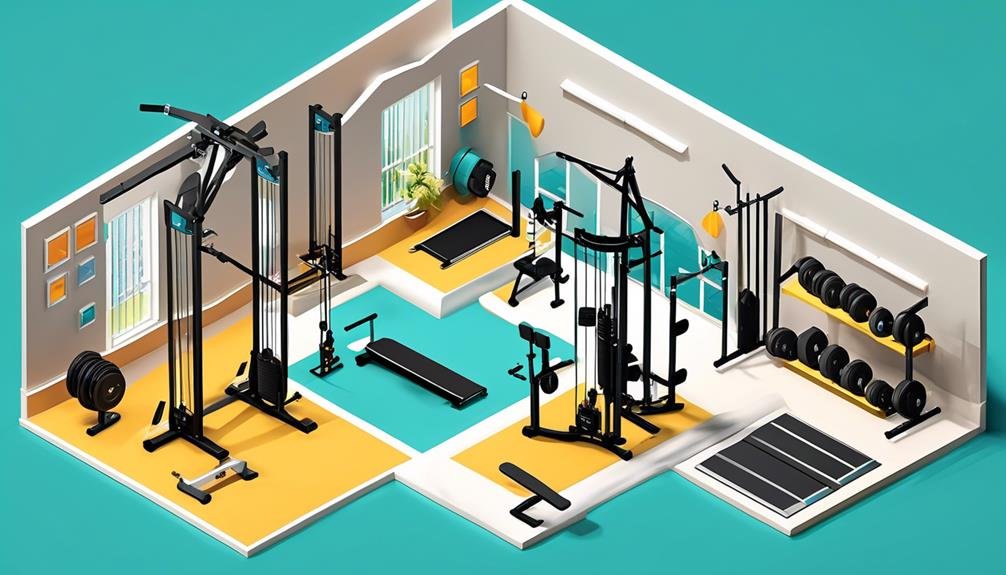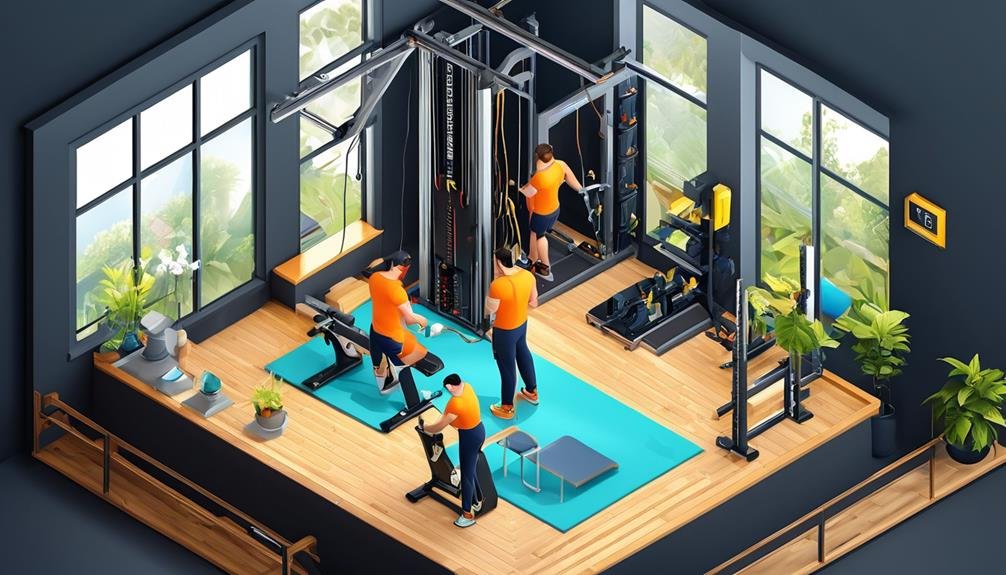Disclaimer: This content is for informational purposes only and does not replace professional medical advice, diagnosis, or treatment. Always consult a qualified healthcare provider before beginning any new exercise program.
Like a skilled navigator adjusting the sails of a ship, you have the power to fine-tune your rowing machine settings for the ultimate HIIT workout experience. But where do you begin? With a sea of options at your fingertips, it’s easy to feel overwhelmed. Fear not, for in this discussion, we will unravel the mysteries of adjusting the settings on your rowing machine for HIIT workouts.
From understanding the basics of the damper setting and drag factor to customizing resistance and maximizing efficiency, we will guide you through the depths of this topic, empowering you to conquer your fitness goals with each stroke.
So, tighten your grip, steady your focus, and prepare to embark on a journey that will transform your HIIT workouts into a tide of exhilaration and achievement.
Key Takeaways
- The damper setting on a rowing machine adjusts the airflow into the flywheel housing, but it does not directly control the resistance.
- Starting with a damper setting of 3-5 is recommended for most users, but lower settings can still provide an effective workout.
- The drag factor, which can be adjusted by changing the damper settings, determines the resistance felt during a rowing stroke.
- Experiment with different damper settings and drag factors to find the optimal resistance and intensity for your HIIT workouts.
Damper Setting Basics
Understanding the basics of damper settings is crucial for controlling the feel of rowing on a rowing machine. The damper setting on a rowing machine adjusts the airflow into the flywheel housing, affecting how rowing feels. It’s important to note that the damper setting doesn’t directly control the resistance of the rowing machine. Resistance is generated by the spinning flywheel and is determined by how hard you pull, not the damper setting. The damper settings are numbered from 1 to 10, with higher settings drawing in more air and making rowing harder, while lower settings allow less air and make rowing easier.
When it comes to HIIT workouts or interval training on a rowing machine, the damper setting plays a role in determining the intensity of your workout. For most users, starting with a damper setting of 3-5 is recommended. This allows you to focus on technique and gradually improve without overwhelming yourself. However, it’s important to note that lower damper settings can provide an effective workout and yield great results.
Different damper settings can be used for varying workouts. Lower damper settings are best suited for aerobic workouts, focusing on endurance and cardiovascular fitness. On the other hand, higher damper settings are more suitable for strength-focused sessions, allowing you to increase the drag factor and challenge your muscles.
Adjusting Drag Factor
To adjust the drag factor on a rowing machine, locate the damper lever on the side of the flywheel housing and set it to a higher number for more resistance or a lower number for less resistance, allowing you to customize your workout intensity. The drag factor is the measure of the resistance you feel when pulling the handle during your rowing stroke. By adjusting the damper settings, you can increase or decrease the drag factor to suit your preferences and goals.
For high-intensity interval training (HIIT) workouts, adjusting the drag factor is essential. HIIT workouts involve alternating between periods of intense exercise and short rest intervals. By increasing the drag factor, you can make the rowing machine feel more challenging, which can help increase the intensity of your workout. This can be beneficial for improving cardiovascular fitness, building strength, and burning calories.
On the other hand, you may choose to decrease the drag factor for lower-intensity workouts or when focusing on technique and endurance. Lower drag settings allow for a smoother rowing stroke and can help you maintain a steady pace over longer distances.
Experiment with different drag factor settings to find the optimal resistance for your HIIT workouts. It’s important to consider your fitness level, work-to-rest ratio, and personal goals when adjusting the drag factor. Remember to warm up properly before starting your workout and listen to your body to prevent injury and ensure a safe and effective workout.
HIIT Rowing Workout Intensity

For an effective and challenging HIIT rowing workout, adjust the damper setting on your rowing machine to a level between 3-5. The damper setting controls the airflow into the flywheel, which affects the resistance you feel while rowing. A higher damper setting increases the resistance, making your workout more intense. However, it’s important to find the right balance based on your fitness level and training goals.
During a HIIT rowing workout, you’ll perform short bursts of high-intensity rowing followed by brief rest intervals. A common protocol is 20 seconds of max-effort rowing followed by 10 seconds of rest. Aim for 8-10 sets with 3-5 rounds, adjusting the intensity based on your fitness level.
To further customize the intensity of your HIIT rowing workout, you can also consider the drag factor. The drag factor measures the resistance you feel on each stroke and can be adjusted by changing the damper setting and stroke rate. A higher drag factor means more resistance and a more intense workout.
As you progress, you can increase the difficulty of your HIIT rowing workout by reducing the rest interval. Start with a 1:2 work-to-rest ratio and gradually decrease the rest time as you improve. This will challenge your cardiovascular system and help you improve your endurance.
Remember to listen to your body and adjust the intensity of your HIIT rowing workouts based on your own abilities and goals. Push yourself, but also allow for proper recovery to avoid overtraining and injury.
Customizing Resistance for HIIT
Adjusting the resistance on your rowing machine is essential for customizing your HIIT workout and maximizing its effectiveness.
To customize the resistance for your HIIT rowing workouts, you can adjust the damper lever on your rowing machine. The damper lever controls the drag factor, which determines the amount of air resistance you face while rowing.
For high intensity interval training (HIIT), it’s recommended to set the damper level between three and five. This provides an optimal balance of resistance and speed, allowing you to challenge yourself without causing excessive fatigue.
However, it’s important to note that the best workout intensity will vary based on your fitness level and personal physique goals. Therefore, it’s a good idea to experiment with different damper settings to find the one that works best for you.
Additionally, remember to prioritize a proper warm-up and focus on improving your technique with each stroke to maximize the benefits of the customized resistance for your HIIT rowing workout.
As you progress and improve, you can increase the difficulty of your workout by reducing the rest period between intervals while maintaining the 1:2 work-to-rest ratio initially. This will help you continuously challenge yourself and make progress in your HIIT rowing training.
Incorporating sprint intervals and strength training exercises into your HIIT rowing workouts can also enhance the effectiveness of your training.
Remember to listen to your body and adjust the resistance and intensity based on your individual needs and abilities.
Maximizing Efficiency on the Rowing Machine

Maximize your efficiency on the rowing machine by incorporating high-intensity intervals and utilizing proper warm-up techniques.
To get the best out of your HIIT workouts on the rowing machine, it’s important to adjust the settings and settings properly. For resistance, the damper setting on the rowing machine should be set between 3 and 5. This will optimize the drag factor and give you the right amount of resistance and intensity for your workout.
When it comes to the actual workout, incorporating intervals is key to maximizing efficiency. For example, Tabata intervals are a popular choice for rowing HIIT workouts. This involves rowing at maximal effort for 20 seconds, followed by 10 seconds of rest. Repeat this cycle for a total of 4 minutes. This type of interval training is effective in improving cardiovascular fitness and burning calories.
If you’re a beginner or looking to gradually increase the intensity, a good option is to use a 1:2 work-to-rest ratio. This means rowing at a challenging pace for 20 seconds, followed by 40 seconds of rest. This allows you to push yourself during the work intervals and recover adequately before the next round.
Lastly, don’t forget to warm up properly before diving into a high-intensity session. Spend 3-5 minutes rowing at an easy pace to warm up your major muscle groups and prepare your body for the workout ahead.
Tips for Effective HIIT Settings Adjustments
To optimize your HIIT workouts on the rowing machine, it’s essential to make effective adjustments to the settings. One important setting to consider is the damper setting, which controls how much air flows into the flywheel. This setting affects the drag factor, or the resistance you feel when rowing. For HIIT workouts, it’s recommended to set the damper to a moderate level, usually between 3 and 5. This balance of resistance and intensity allows you to exert maximum effort during the work intervals while still maintaining control and proper form.
By setting the drag appropriately, you can make the most out of your HIIT sessions. A higher drag setting will make the boat go faster, but it requires more force to maintain that speed. This higher resistance translates to a higher calorie burn and a greater strength-building effect. On the other hand, a lower drag setting allows for a smoother and more aerobic-focused workout.
When adjusting the damper, it’s important to understand that it measures how much air is allowed into the flywheel, not the resistance level itself. The damper setting controls the rate of deceleration of the flywheel when you stop applying force. So, finding the right balance for your HIIT workouts is crucial to achieving optimal results.
Remember to experiment with different damper settings to find what works best for you. And always prioritize a proper warm-up and technique to prepare your body for the intensity of HIIT rowing sessions.
Frequently Asked Questions
Can You Do a HIIT Workout on a Rowing Machine?
Yes, you can do a HIIT workout on a rowing machine. It’s a great way to improve strength, stamina, and cardiovascular fitness. Adjust the damper setting and incorporate sprint intervals for an effective workout.
How Can I Make My Rowing Machine More Intense?
To make your rowing machine more intense, adjust the damper setting between 3-5. Increase difficulty by reducing rest intervals as you improve. Experiment with different settings and use the Performance Monitor to track and adjust your performance.
What Setting Should My Rowing Machine Be On?
Adjust the damper setting on your rowing machine to a level between three and five for HIIT workouts. Experiment with different settings to find what works best for you, considering the type of workout and environmental factors.
What Is the Best Intensity for Rowing Machine?
The best intensity for rowing machine workouts is high-intensity interval training (HIIT). Push yourself for short bursts followed by rest, gradually increasing difficulty. Adjust the damper setting between three and five for optimal results.
Conclusion
In conclusion, adjusting the settings on your rowing machine for HIIT workouts involves focusing on the damper setting and drag factor.
The damper setting controls the airflow and can be adjusted from 1 to 10, while the drag factor affects the resistance.
By finding the right combination of these settings, you can customize the intensity and resistance for your HIIT workouts, maximizing efficiency and achieving optimal results on the rowing machine.



